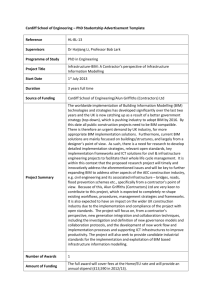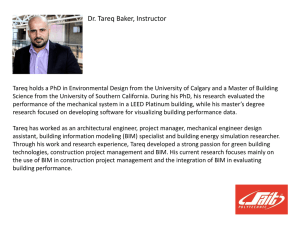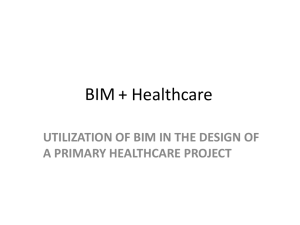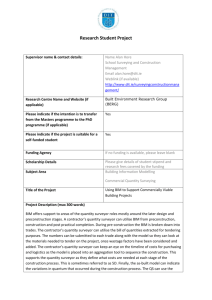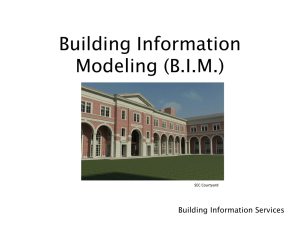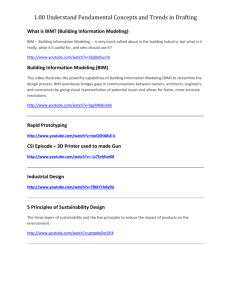PROJECT REQUIREMENT, PR – 20 VIRTUAL DESIGN
advertisement
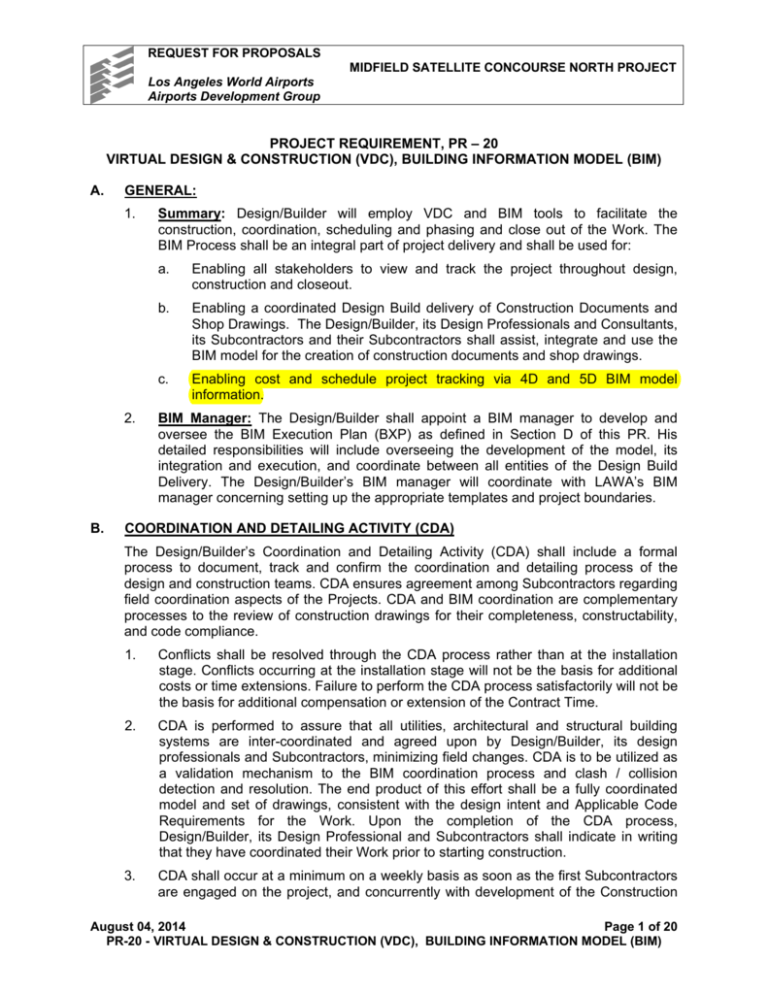
REQUEST FOR PROPOSALS MIDFIELD SATELLITE CONCOURSE NORTH PROJECT Los Angeles World Airports Airports Development Group PROJECT REQUIREMENT, PR – 20 VIRTUAL DESIGN & CONSTRUCTION (VDC), BUILDING INFORMATION MODEL (BIM) A. GENERAL: 1. 2. B. Summary: Design/Builder will employ VDC and BIM tools to facilitate the construction, coordination, scheduling and phasing and close out of the Work. The BIM Process shall be an integral part of project delivery and shall be used for: a. Enabling all stakeholders to view and track the project throughout design, construction and closeout. b. Enabling a coordinated Design Build delivery of Construction Documents and Shop Drawings. The Design/Builder, its Design Professionals and Consultants, its Subcontractors and their Subcontractors shall assist, integrate and use the BIM model for the creation of construction documents and shop drawings. c. Enabling cost and schedule project tracking via 4D and 5D BIM model information. BIM Manager: The Design/Builder shall appoint a BIM manager to develop and oversee the BIM Execution Plan (BXP) as defined in Section D of this PR. His detailed responsibilities will include overseeing the development of the model, its integration and execution, and coordinate between all entities of the Design Build Delivery. The Design/Builder’s BIM manager will coordinate with LAWA’s BIM manager concerning setting up the appropriate templates and project boundaries. COORDINATION AND DETAILING ACTIVITY (CDA) The Design/Builder’s Coordination and Detailing Activity (CDA) shall include a formal process to document, track and confirm the coordination and detailing process of the design and construction teams. CDA ensures agreement among Subcontractors regarding field coordination aspects of the Projects. CDA and BIM coordination are complementary processes to the review of construction drawings for their completeness, constructability, and code compliance. 1. Conflicts shall be resolved through the CDA process rather than at the installation stage. Conflicts occurring at the installation stage will not be the basis for additional costs or time extensions. Failure to perform the CDA process satisfactorily will not be the basis for additional compensation or extension of the Contract Time. 2. CDA is performed to assure that all utilities, architectural and structural building systems are inter-coordinated and agreed upon by Design/Builder, its design professionals and Subcontractors, minimizing field changes. CDA is to be utilized as a validation mechanism to the BIM coordination process and clash / collision detection and resolution. The end product of this effort shall be a fully coordinated model and set of drawings, consistent with the design intent and Applicable Code Requirements for the Work. Upon the completion of the CDA process, Design/Builder, its Design Professional and Subcontractors shall indicate in writing that they have coordinated their Work prior to starting construction. 3. CDA shall occur at a minimum on a weekly basis as soon as the first Subcontractors are engaged on the project, and concurrently with development of the Construction August 04, 2014 Page 1 of 20 PR-20 - VIRTUAL DESIGN & CONSTRUCTION (VDC), BUILDING INFORMATION MODEL (BIM) REQUEST FOR PROPOSALS MIDFIELD SATELLITE CONCOURSE NORTH PROJECT Los Angeles World Airports Airports Development Group Drawings. CDA milestone submittals shall be required with the 60%, 90%, and 100% progress submittals. 4. The provisions of this Section shall not reduce the Design/Builder's responsibility to provide adequate coordination for all Work including Work not indicated above. 5. LAWA, the Design/Builder's Project staff, Subcontractors, and Design Professionals shall participate in this program. At the completion of the CDA, the Design/Builder, its design professionals and Subcontractors are required to sign off on their acceptance. Signatures shall indicate that the Work represented on the CDA drawings is constructible and has been reviewed by Design/Builder, Design/Builder’s Design Professionals, and Subcontractors and all are in concurrence with information contained on the CDA Drawings. 6. CDA drawings shall be 2d or axonometric print outs of the BIM models and shall be usable as field documents aimed at coordination and allocation of work between different trades (structure, framing, casework, ceilings, ductwork, plumbing and mechanical piping, electrical and LV conduits and outlets, MEP and architecturally or structurally significant equipment, miscellaneous anchorage, supports and bracing of different trades, exterior wall components, code clearances, etc.). 7. Exterior Wall Coordination: Separate Overlay Drawings for Coordination of All Miscellaneous Steel and/or Structural Stud Systems on Background Drawings and Elevations: Illustrate the connection points of the precast, windows, curtain wall, stone, metal panel systems, as well as all elements that will be contained in the exterior wall systems including but not limited to recessed electrical, communications outlets, security devices, panels, telephones, recessed water connections, lighting and alarms, the Design/Builder’s Design Build team shall prepare an overlay CDA drawing for all recessed systems. 8. CDA Drawings: The Design/Builder shall prepare CDA Drawings to optimize the utilization of space, provide for efficient installation of different components, and coordinate the installation of products and materials. The CDA drawings shall be the basis for coordinated shop drawings. Additional shop drawings shall not be produced after signing off CDA drawings without review, verification, and sign-off by all trades that changes did not impact agreed-upon coordination. There are other potential areas of the building systems that will require a process for completion. These should be illustrated in the Design/Builder’s work plan and schedule. 9. Orientation Meeting: The Design/Builder, its Design Professionals, Consultants, Subcontractors, and LAWA shall hold an orientation meeting prior to the beginning of the CDA effort. The purpose of this meeting is to develop a mutual understanding of the administration of the CDA, and the scope of the required submittals and Drawings. All personnel involved in coordination and detailing of the work and the BIM model of shall attend the Orientation Meeting. The meeting shall be administered by the Design/Builder’s BIM manager and the Design/Builder’s MEP / Systems Coordinator. 10. CDA Meetings: During CDA and its Subcontractors shall building elements, problems minimum, CDA meetings will meetings the Design/Builder, its design professionals discuss and coordinate the locations of utilities and of fit, trade interfaces, and constructability. As a be biweekly prior to the CDA finish milestone. LAWA August 04, 2014 Page 2 of 20 PR-20 - VIRTUAL DESIGN & CONSTRUCTION (VDC), BUILDING INFORMATION MODEL (BIM) REQUEST FOR PROPOSALS MIDFIELD SATELLITE CONCOURSE NORTH PROJECT Los Angeles World Airports Airports Development Group may attend all CDA meetings. The Design/Builder shall prepare and distribute meeting minutes to document session resolution decisions or track issues requiring further rework of the drawings and re-coordination. 11. C. Conflict Resolution Plan: Design/Builder must provide leadership in the space allocation, and adjusting of previous designs in order to resolve BIM conflicts in an effective and timely manner while maintaining design quality, and maintenance space allocation. Specialty Subcontractors shall work with the Design/Builder’s MEP Coordinator to identify alternate acceptable routes to resolve conflicts. The Design/Builder shall be present to provide leadership and assign responsibilities as required to find alternate routing methods for conflict resolution. Resolve Conflicts and Re-detail or re-model as required. Generate a conflict list that shall identify all systems that are in conflict with another building system. Revise discipline models as required to avoid a particular building systems that cannot be relocated. Revise the discipline models with the intent of eliminating the interference’s and conflicts. BUILDING INFORMATION MODEL (BIM): Design/Builder's BIM MODEL shall include at a minimum the following: 1. Development and maintenance of a three-dimensional building information model of the Work that includes Design/Builder - developed, shop-drawing level information of the following building components and systems: a. Underground, including but not limited to, utilities: piping, connections, vaults, manholes, tanks, valves, vents, and structural: shoring, shafts, tunnels, and impact zones. b. Airfield civil including Aircraft aprons and taxilanes, underground hydrant fueling and other systems. c. Building structure, including but not limited to foundations, columns, beams, joists, purlins, floor and roof decking and fill, bracing, and load-bearing walls. d. HVAC systems, including but not limited to HVAC piping and pumps, air distribution ductwork, fans, air terminal units, tanks, grease, interceptors, air outlets and inlets; central cooling equipment compressors, chillers, condensers, and cooling towers; boilers, heat exchangers and packaged and/or custom airhandling units, tanks, grease interceptors, and thermal storage systems and supplementary structural support members, hangers, and seismic support. e. Plumbing systems, including but not limited to water distribution, storm drainage and sanitary sewerage waste and vent piping, water-heaters and plumbing fixtures systems and supplementary structural support members, hangers, and seismic support. f. Fire suppression systems, including but not limited to, standpipes, sprinkler systems, fire pumps, and non-water-based fire-extinguishing systems and supplementary structural support members, hangers, and seismic support. g. Electrical systems, including but not limited to conduit 1-112 inches in diameter and larger , or bundled conduits, cable-tray, transformers, switchgear, panel August 04, 2014 Page 3 of 20 PR-20 - VIRTUAL DESIGN & CONSTRUCTION (VDC), BUILDING INFORMATION MODEL (BIM) REQUEST FOR PROPOSALS MIDFIELD SATELLITE CONCOURSE NORTH PROJECT Los Angeles World Airports Airports Development Group boards, generators, lightning protection and lighting and supplementary structural support members, hangers, and seismic support. h. Communication, security, access control, alarm monitoring (ACAMS), and wireless systems, including but not limited to, structured cabling, premise wiring distribution system, equipment room fittings, racks, frames and enclosures, data communications switches, hubs, and routers, common use systems, and paging systems and supplementary structural support members, hangers, and seismic support. i. Conveying systems including elevators, escalators, and moving walks and equipment control cabinets, passenger boarding bridges and ramp service equipment. j. Baggage handling systems including indication of clear right-of-way required around conveyors and catwalks, access ramps, no-fly access zones, supplementary structural support, and equipment Control cabinets. k. Architectural building systems including interior and exterior walls, windows, curtain walls, ceilings, and roof. 2. Coordination and Detailing Activity (CDA) and Collision Detection: Based on information developed and included in the Design/Builder's three dimensional BIM model, perform weekly collision/interference checking and develop reports for review and resolution by the integrated Design/Builder team, including the design team, Subcontractors, manufacturers and suppliers, prior to release of fabrication drawings. Ensure all drawings and backgrounds are coordinating at all levels of detail necessary for fabrication and field installation. Refer to the Coordination and Detailing Activity section in this PR for requirements. 3. Schedule and Cost Visualization (4D and 5D): Develop, update and maintain Schedule and Cost tracking information and all meta data required by LAWA and described in this PR. Develop and maintain 4D and 5D BIM information with the expressed purpose of visually demonstrating and communicating proposed project construction schedule, phasing, and cost tracking to LAWA and its consultants, the Design/Builder’s design team, and Subcontractors and their Subcontractors and suppliers as applicable. The model shall include all major building systems and shall be constructed in such a fashion as to permit animation showing sequential construction of the project based on and driven by the approved construction schedule. 4. Architectural Visualization: Develop three dimensional renderings using the BIM model and enhance with rendering programs to clearly illustrate the architectural (aesthetic) design, as described in the Project Requirement – Scope of Work. 5. Use of BIM for Facility Management and Maintenance: Upon completion and commissioning of the Project, LAWA’s goal is to use the Design/Builder’s Record Model prepared in BIM software for integration into its Building Management and Maintenance. During the preparation of Construction Documents, the Design/Builder shall meet with LAWA’s operations and maintenance staff and discuss specific requirements that shall be built into the BIM model. It is the intent that any implementation of additions to the BIM design model for Building Monitoring August 04, 2014 Page 4 of 20 PR-20 - VIRTUAL DESIGN & CONSTRUCTION (VDC), BUILDING INFORMATION MODEL (BIM) REQUEST FOR PROPOSALS MIDFIELD SATELLITE CONCOURSE NORTH PROJECT Los Angeles World Airports Airports Development Group Management and Maintenance will be included as part of future task authorizations. Refer to Project Requirement for Project Closeout. D. BIM EXECUTION PLAN (BXP): 1. The Design/Builder shall prepare a BIM Execution Plan (BXP) to include master information/data management and assignment of roles and responsibilities for model creation and data integration at project startup. The BXP shall be submitted no later than 30 days after the first NTP and shall address use of multiple software products, training of staff, collaboration and sharing of information models on a common review software platform for open communication and effectiveness of clash detection, and graphic presentations of multi-discipline integrated design. The plan shall highlight responsible individuals designated to manage discipline coordination, and attend regular Design/Build Team coordination meetings. The plan should include, or address the following: a. List of specialty Subcontractors using digital fabrication. b. Proposed BIM Software to be used by the Design/Build Team and fabrication modelers. c. Proposed specialty Subcontractor BIM workshops and training integrated into project schedule. d. Proposed uses of digital fabrication. e. Strategy to assure all trade information is modeled and coordinated. f. Discipline coordination strategy for clash detection via the CDA process. g. Development strategy from Design to Construction Model. h. Constructability analysis with BIM. i. Development of graphics showing installation methods for building equipment and systems. j. Space allocation showing space clearance reservations for operations, repair, maintenance, and replacement. k. Strategy for software compatibility, file formats, hosting, transfer, and access of data between disciplines. l. Use of model server, extranet, access security, etc. m. Use of 4D scheduling and construction sequencing technology, including submission and monthly update process. n. Use of 5D cost loading technology, including submission and monthly update process. o. Use of Commissioning and facilities management related technology. p. List of final BIM deliverable for each respective discipline. q. Updating as-built conditions in As-built/Record BIM. August 04, 2014 Page 5 of 20 PR-20 - VIRTUAL DESIGN & CONSTRUCTION (VDC), BUILDING INFORMATION MODEL (BIM) REQUEST FOR PROPOSALS MIDFIELD SATELLITE CONCOURSE NORTH PROJECT Los Angeles World Airports Airports Development Group E. 2. Model Management during Construction: The BXP shall describe the process of developing the Record As-built Model from continuous updates of the Construction Model. All as-built information shall be reconciled and included in the record model. The Design/Builder shall continuously update the BIM model to include RFI’s, Change Orders, Submittals, and all other changes affecting the project’s design and construction. The Design/Builder shall demonstrate continuous updating of the model and submit status on a monthly basis. An updated model is a payment requirement as stated in the Special Conditions. 3. As-built Construction Model Creation and Delivery: The BIM model, as it is updated throughout the project duration, shall represent in electronic format the physical design and construction of the project throughout all trades. The Design/Builder shall provide the Record as-built model as required in the Project Requirements for Project Closeout. BIM MODELING REQUIREMENTS 1. Summary: The Design/Builder shall develop and submit for approval a Federated Model (Fed Model) of the Project utilizing a Building Information Modeling (BIM) system as defined by this Section. The Design/Builder shall: a. Manage communication and coordination between the Design/Builder’s design professionals and Subcontractors to develop the Fed Model throughout the Work of the Project. b. Submit a LOD 300 Fed Model to LAWA for review and approval as part of the 60% Drawings submission. c. Use the Fed Model to facilitate the construction methods and means. d. Update the Fed Model progressively throughout the construction period to incorporate all construction actions so that the Fed Model shall be developed to LOD 400 construction level, including: 1) Shop Drawings 2) Approved Change Orders 3) Fabrication, assembly and detailing 4) Field Modifications e. Submit the Model to LAWA for review and approval at 90% and 100% completion of the Work of the Project. f. Provide a final “as-built” LOD 500 Fed Model to LAWA as part of the Project Close-Out phase. 2. Definitions: (Refer to General Conditions for definitions) 3. Use of Federated Model and As-Built Model (Reconciled Design Model RDM) a. The Design/Builder shall prepare and maintain the Federated Model and the Design Model throughout the duration of the project. At the completion of the Work these models shall be turned over to LAWA. LAWA shall have exclusive August 04, 2014 Page 6 of 20 PR-20 - VIRTUAL DESIGN & CONSTRUCTION (VDC), BUILDING INFORMATION MODEL (BIM) REQUEST FOR PROPOSALS MIDFIELD SATELLITE CONCOURSE NORTH PROJECT Los Angeles World Airports Airports Development Group rights to the models for their use: 1) as an as-built model for future modification to the constructed facilities and 2) as a source of data in operating and maintaining the facility. The Reconciled Design Model (s) (RMD), prepared by licensed design professionals, shall have the legal bearing of the Design Intent. 4. b. Basis of Information for Modeling: The Construction Documents (drawings and specifications) shall be the basis of information for the Fed Model described herein. If any or all of the LAWA’S own models are available for use by the Design/Builder in developing the Fed Model, such usage shall be for convenience only and shall not carry contractual implication. c. Relation of BIM to other Contract Documents: If the Design/Builder through developing and/or use of the BIM or Fed Model identifies any potential changes that the Design/Builder thinks should be reflected in changes to the Contract Documents, the Design/Builder shall produces the necessary changes via Change Order after notifying LAWA of a potential Change Order(s). d. Changes by Others: All changes to the Fed Model, subsequent to completion of the Work, including additional modeling by others, shall be solely the responsibility of the entity providing the changes or additions. ASTM UNIFORMAT II Classification System: Every Object in the Native Model shall have a classification code. The UNIFORMAT II system is a combination of letters, numbers and nomenclature, and is formatted as shown in the following example: a. Level 1; Major Group Elements: for example: B Shell. b. Level 2; Group Elements: for example: B20 Exterior Enclosure. c. Level 3; Individual Elements: for example: B2030 Exterior Door. The Design/Builder shall include the appropriate UNIFORMAT II classification in the list of attributes that is assigned to the Objects. 5. OmniClass Construction Classification a. General: The OmniClass Construction Classification System (known as OmniClass or OCCS) is a classification system for the construction industry developed by the Construction Specification Institute (CSI). It builds upon MasterFormat for work results, UniFormat for elements and EPCI (Electronic product Information Cooperation) for structuring products. OmniClass is a reference library system that will serve as the foundation upon which information is transferred between the construction and operations phases. b. OmniClass automatically assigned: The Design/Builder shall include the appropriate OmniClass classification in the list of attributes that are automatically assigned to the Objects by the Model software. c. Exception when OmniClass not automatically assigned: The Design/Builder is not required to include the appropriate OmniClass classification in the list of attributes a discipline Native Model if that particular Native Model software does not automatically assigned the classification to its Objects. This exception applies only to the Native Model software that does not automatically assign August 04, 2014 Page 7 of 20 PR-20 - VIRTUAL DESIGN & CONSTRUCTION (VDC), BUILDING INFORMATION MODEL (BIM) REQUEST FOR PROPOSALS MIDFIELD SATELLITE CONCOURSE NORTH PROJECT Los Angeles World Airports Airports Development Group the classification; for all other Native Models that do automatically assign the classification, it shall still be provided. 6. 7. Commissioning and COBIE Requirements a. General: If commissioning activities and/or COBIE data is required by other sections of these specifications, the Design/Builder shall comply with the requirements of those sections in addition to the requirements of this section. b. Commissioning requirements: The scope of work related to Commissioning, if required, shall be provided in accordance with the Commissioning section. In addition, and in support of, the extent of Model and Object parametric data required by this section shall be provided as described herein with modifications as follows: 1) The submittal of the Model data shall be as scheduled by the Commissioning requirements. 2) The Model data shall be formatted as required by the COBIE Data Sets requirements. 3) The submittal of the Model data shall be as scheduled by the COBIE requirements. Level of Development (LOD) The American Institute of Architects has developed a Level of Development (LOD) system which serves as the basis for this Project with Project-specific modifications as shown in the following requirements. a. General: Regardless of LOD, the model(s) shall be capable of being presented in three dimensions, and shall be an object-based parametric database system. b. LOD 100: This is the “programming” level. Buildings and/or structures shall be modeled as masses indicative of area, height, volume, spatial location, and orientation. c. LOD 200: This is the “planning” level. Buildings and/or structures including major architectural, structural, mechanical, electrical, and plumbing objects shall be modeled as generalized systems or assemblies with approximate quantities, approximate configuration, spatial location, and orientation. Each enclosed space shall be identified as a unique Room with associated parameters. d. LOD 300: This is the “design” level. Buildings and/or structures including all objects shall be modeled as specific systems or assemblies with accurate quantities, recognizable configuration, spatial location, and orientation. Each enclosed space shall be identified as a unique Room with associated parameters. e. LOD 400: This is the “construction” level. Buildings and/or structures including all objects shall be modeled as specific systems or assemblies with accurate quantities, recognizable configuration, spatial location, and orientation, with complete fabrication, assembly, and detailing information. Each enclosed space shall be identified as a unique Room with associated parameters. August 04, 2014 Page 8 of 20 PR-20 - VIRTUAL DESIGN & CONSTRUCTION (VDC), BUILDING INFORMATION MODEL (BIM) REQUEST FOR PROPOSALS MIDFIELD SATELLITE CONCOURSE NORTH PROJECT Los Angeles World Airports Airports Development Group f. 8. LOD 500: This is the “as-built” level. Buildings and/or structures including all objects shall be modeled as constructed systems or assemblies with accurate quantities, shape, spatial location, and orientation, with complete fabrication, assembly, and detailing information. Each enclosed space shall be identified as a unique Room with associated parameters. Native Model Software – Minimum Requirements a. General: The Native Model(s) shall be developed to include parametric components of major building and site elements as defined in this Section. All discipline Native Models shall be linked to the Architectural Native Model. b. Accuracy of the Models: The Fed Model and each of its Native Models shall be developed to within a tolerance of ¼” plus or minus. c. BIM application(s) and software(s) for the Fed Model shall: 1) Have maximum interoperability between systems models, and shall be fully compatible with the current version of Autodesk® Navisworks software. 2) Be provided in a format that is compatible with a free software download for viewing the Design/Builder’s models with the ability to save and track user annotations and notes. 3) Contain reports/logs of: a) Discrepancies and/or clarifications in the Construction Documents identified during the modeling process. b) Conflicts between location and alignment of model elements with resolutions developed by the Design/Builder. c) Quantities of modeled building element. d) Schedule for each building element. d. For any additional electronic model information that is not supported by the Revit or the primary software solution approved by LAWA, and for constructing 4D models, the Design/Builder shall utilize Navisworks software (Manage, Review, Simulate and Freedom) to create and utilize .nwd files. e. The Design/Builder shall use the latest version of Native Model software listed in the matrix below: Acceptable Native Model Software Matrix Discipline Native Model Software Architectural Revit Architecture Fixtures, and Equipment Revit Architecture Structural Revit Structure Comments Applies to stationary items only August 04, 2014 Page 9 of 20 PR-20 - VIRTUAL DESIGN & CONSTRUCTION (VDC), BUILDING INFORMATION MODEL (BIM) REQUEST FOR PROPOSALS MIDFIELD SATELLITE CONCOURSE NORTH PROJECT Los Angeles World Airports Airports Development Group HVAC Revit MEP AutoCAD MEP CAD-Duct Plumbing Revit MEP AutoCAD MEP CAD-Pipe Fire Protection Electrical AutoSPRINK v 7 Revit MEP AutoCAD MEP Security Electronics Revit MEP AutoCAD MEP 9. AutoCAD Civil 3D Hardscape Revit Architecture Object Identification a. General: Every Object in the Model shall have a Unique Identification (UID) parameter and a Common Name parameter attached to it in the Native Model. b. Unique Identification: The UID shall be readable by the user of the Native Model software without additional software applications. The UID may be in the form of alpha, numeric, or alpha-numeric. c. 10. Civil 1) If the UID form is alpha-numeric, it shall be a consistent string format for all Objects, within its discipline, and shall be readable by any commonly available database. The UID is an “Instance” parameter. 2) If the Native Model software is not a full object-based, parametric, database platform, such as some of the older 3D CAD programs, the UID shall be attached to the Object manually, if necessary, so that it can be read by the user without additional software applications. Common Name: In addition to the UID, each Object shall have a Common Name parameter attached to it in the Native Model. The Common Name shall be approved by LAWA prior to modeling. Examples of a Common Name include such as: door, window, toilet, VAV Box, etc. Typically the Common Name will be generated automatically by the software, but if not, it shall be input manually in the Native Model. The Common Name is an Object “Type” parameter. Object Parametric Attributes – Minimum Requirements The following attributes shall be attached to each Object. Note: If a required attribute is not automatically generated by Native Model software, it shall be manually input in the Native Model, or provided in an Excel or Access document that includes the UID. August 04, 2014 Page 10 of 20 PR-20 - VIRTUAL DESIGN & CONSTRUCTION (VDC), BUILDING INFORMATION MODEL (BIM) REQUEST FOR PROPOSALS MIDFIELD SATELLITE CONCOURSE NORTH PROJECT Los Angeles World Airports Airports Development Group 11. a. Unique Identification (Instance parameter). b. Common Name (Type parameter). c. Uniformat II Classification Code Levels 1, 2, and 3 (Type parameter). d. Omni Code Classification (Type parameter). e. Native Model Assembly Code (Type parameter). f. Manufacturer (where applicable) (Instance parameter). g. Model Number (where applicable) (Instance parameter). Object Association a. Every Object in the Model shall be associated with either a Room or a Floor and shall have an association “Instance” parameter attached to it in the Native Model. b. Room association: Any Object that will be visible in a Room of the completed facility shall be associated with that specific Room. This includes all Objects regardless of responsible discipline; examples include without limitation: electrical switches and outlets, electrical switch gear and panel boards, plumbing equipment and fixtures, access panels to concealed Objects, cabinets, doors and frames, wainscot, light fixtures, HVAC supply and return grilles, fire sprinkler heads and valves, etc. c. Floor association: Any Object that will be concealed in a wall or interstitial space (but would be visible if the finish surface or item was non-existent) shall be associated with the specific Floor level that it is within. This includes all Objects regardless of responsible discipline; examples include without limitation: electrical conduit, plumbing piping and valves, HVAC supply and return ducts, HVAC equipment, fire sprinkler lines and valves, etc. d. Objects extending beyond Room boundaries: Floors, walls, and/or ceilings are sometimes modeled as objects that extend beyond individual Room boundaries. Where this occurs, the architectural discipline Native Model shall be modeled as follows: 1) Floors: Structural floor Objects may extend beyond Room boundaries, however, finish flooring such as carpet, resilient flooring, etc., shall be modeled as Objects, with extents contained within the Room boundaries, and with appropriate Room association. 2) Walls: Structural wall and non-structural partition Objects may extend beyond Room limits, however, the surface material such as gypsum wallboard, wall covering, etc., shall be modeled as Objects, or scheduled in the Room Finish Schedule, with extents contained within the Room boundaries, and with appropriate Room association. 3) Ceilings: Structural ceiling Objects may extend beyond Room limits, however, finish surface material such as gypsum wallboard, acoustical ceiling tiles, etc., shall be modeled as Objects, with extents contained within the Room boundaries, and with appropriate Room association. August 04, 2014 Page 11 of 20 PR-20 - VIRTUAL DESIGN & CONSTRUCTION (VDC), BUILDING INFORMATION MODEL (BIM) REQUEST FOR PROPOSALS MIDFIELD SATELLITE CONCOURSE NORTH PROJECT Los Angeles World Airports Airports Development Group 12. Building Information Modeling System Discipline Models a. Civil Systems: The Civil Systems Model shall be a sub-system model linked to the Architectural System Model. The Civil Systems Model shall serve as the basis for project shared coordinates through which the position of building elements on the site will be coordinated. Where applicable, provide model Objects of: 1) 2) 3) 4) 5) 6) Topography: a) Existing natural and/or graded contours. b) New grades and finish contours. Planting: a) Existing major landscaped areas. b) Existing trees to remain. c) New landscaped areas. d) New trees. e) Irrigation lines over 2” diameter. Surface Improvements: a) Pavements (aprons, taxilane, taxiways). b) Curbs and gutters. c) Retaining walls. d) Exterior non-building structures such as tanks, shade structures etc. Existing Structures: a) All buildings within the project area intended to remain b) Buildings intended to be demolished. c) All existing structures may be modeled exterior surface only. d) Interior elements are not required. Storm Water and Sanitary Sewers: a) Existing lines (over 3” diameter), boxes and structures within project area, b) All new lines, boxes and structures. c) Existing public lines, boxes and structures beyond the project area but serving as points of connection for the project. Utilities: a) Existing domestic and fire water main and branch lines (2” and larger diameter) within project area. b) All new domestic and fire water lines. August 04, 2014 Page 12 of 20 PR-20 - VIRTUAL DESIGN & CONSTRUCTION (VDC), BUILDING INFORMATION MODEL (BIM) REQUEST FOR PROPOSALS MIDFIELD SATELLITE CONCOURSE NORTH PROJECT Los Angeles World Airports Airports Development Group 7) b. c) Existing electrical overhead and underground lines within project area, all new electrical lines outside buildings. d) Existing telephone and data lines within project area. e) All new telephone and data lines outside buildings. f) Existing gas lines within project area. g) All new gas lines outside buildings. Other requirements: a) Quantities: data to reflect accurate quantities of the above elements. b) Schedules: data for installation of the above elements. Architectural Systems: The Architectural Systems Model shall be the primary model to which others are linked. Provide model Objects of: 1) 2) 3) 4) 5) Spaces: a) Net square footage of all occupied spaces. b) Gross constructed floor area. c) Room names and numbers. d) Floor, base, wall, and ceiling finishes. NOTE: Model room names and numbers shall match LAWA’s Architectural Program space names and numbers. Exterior Walls and Curtain Walls: a) Type and composition. b) Height, length, and width. c) Thermal, acoustic, fire, and security ratings. Partitions: a) Type and composition. b) Height, length, and width. c) Thermal, acoustic, fire, and security ratings. Floors: a) Type and material. b) Thickness. c) Finishes with manufacturer’s name and product numbers. Link floor structure to the Structural Systems Model. Ceilings: a) Type and composition. b) Height, length, and width. August 04, 2014 Page 13 of 20 PR-20 - VIRTUAL DESIGN & CONSTRUCTION (VDC), BUILDING INFORMATION MODEL (BIM) REQUEST FOR PROPOSALS MIDFIELD SATELLITE CONCOURSE NORTH PROJECT Los Angeles World Airports Airports Development Group c) 6) 7) 8) 9) 10) 11) 12) Thermal, acoustic, fire, and security ratings. Roof Coverings and Openings: a) Configuration. b) Drainage system. c) Penetrations for modeled building components. Exterior Doors, Windows, and Louvers: a) Type and material. b) Height, width, and thickness. c) Thermal, acoustic, fire, and security rating. d) Location. e) Hardware elements or group. Interior Doors, Windows, and Louvers: a) Type and material. b) Height, width, and thickness. c) Thermal, acoustic, fire, and security rating. d) Location. e) Hardware elements or group. Stairs and Ramps: a) Stairs and railings. b) Ramps and railings. c) Handrails and guardrails. Elevators and Escalators: a) Elevator cabs and doors. b) Elevator hoist-way doors and trim. c) Elevator machinery and equipment. d) Escalator belts and railings. e) Escalator machinery and equipment. Casework and Counters: a) Type and material. b) Height, width, and depth. c) Location. d) Hardware. Plumbing Fixtures August 04, 2014 Page 14 of 20 PR-20 - VIRTUAL DESIGN & CONSTRUCTION (VDC), BUILDING INFORMATION MODEL (BIM) REQUEST FOR PROPOSALS MIDFIELD SATELLITE CONCOURSE NORTH PROJECT Los Angeles World Airports Airports Development Group 13) 14) 15) 16) c. a) Type and material. b) Location. c) Trim. d) Finishes: Link fixtures and trim to the Mechanical Systems Model. HVAC Grills and Registers: a) Type and material. b) Location. c) Trim. d) Finishes: Link fixtures and trim to the Mechanical Systems Model. Electrical Fixtures and Equipment: a) Type and material. b) Bulb type and wattage. c) Location. d) Trim. e) Finishes: Link fixtures and trim to the Electrical Systems Model. Miscellaneous Fittings: a) Toilet partitions. b) Toilet room accessories. c) Grab bars. d) Personal storage lockers. e) Display cases. f) Other surface applied quasi-permanent items such as mirrors etc. Other requirements: a) Quantities: data to reflect accurate quantities of the above elements. b) Schedules: data for installation of the above elements. Structural Systems: The Structural Systems Model shall be a sub-system model linked to the Architectural System Model. Provide model Objects of: 1) 2) Foundations and footings: a) Type and configuration. b) Depth, length, and width. Slab(s) on-grade: a) Type and configuration. b) Under-slab base and waterproofing. August 04, 2014 Page 15 of 20 PR-20 - VIRTUAL DESIGN & CONSTRUCTION (VDC), BUILDING INFORMATION MODEL (BIM) REQUEST FOR PROPOSALS MIDFIELD SATELLITE CONCOURSE NORTH PROJECT Los Angeles World Airports Airports Development Group 3) 4) 5) 6) 7) 8) 9) c) Recesses, curbs, pads, closure pours. d) Major penetrations. Basement Walls: a) Type and composition. b) Height, length, and width. c) Thermal, acoustic, fire, and security ratings. Elevated Floors: a) Columns and beams. b) Primary and secondary framing members. c) Bracing. d) Connections. e) Framed, composite, and/or slab decks. Roofs: a) Columns and beams. b) Primary and secondary framing members. c) Bracing. d) Connections. e) Framed, composite, and/or slab decks. Joints: a) Expansion and/or contraction. b) Seismic. Stairs and Ramps: a) Openings and framing. b) Railing supports. Shafts and Pits: a) Openings and framing b) Railing supports. Other requirements: a) Quantities: include data to reflect accurate quantities of the above elements. b) Schedules: data for installation of the above elements. c) Fireproofing: Fireproofing is not to be included in the BIM but clash detection studies shall include definition of tolerances for conflict detection. August 04, 2014 Page 16 of 20 PR-20 - VIRTUAL DESIGN & CONSTRUCTION (VDC), BUILDING INFORMATION MODEL (BIM) REQUEST FOR PROPOSALS MIDFIELD SATELLITE CONCOURSE NORTH PROJECT Los Angeles World Airports Airports Development Group d) d. Mechanical: The Mechanical Systems Model shall be a sub-system model linked to the Architectural System Model. Provide model Objects of: 1) 2) 3) 4) e. Color Code: color code structural steel from other elements. Heating, Ventilating, and Air Conditioning: a) All heating, ventilating, air-conditioning, exhaust fans, and specialty equipment. b) Air supply, return, ventilation and exhaust ducts, including spaceconsuming elbows and transitions. c) Fire dampers with ratings. d) Mechanical piping. e) Registers, diffusers, grills and hydronic baseboards. Coordinate and link fixtures and trim to the Architectural Systems Model. Plumbing: a) All domestic plumbing piping and fixtures. b) Floor and area drains. c) Valves (regardless of pipe size). d) Related equipment. a) Piping larger than 1 .5" diameter shall be modeled. Roof Drainage: a) All piping and fixtures, and 2) related equipment. b) Piping larger than 1 .5" diameter shall be modeled. Other requirements: a) Quantities: data to reflect accurate quantities of the above elements. b) Schedules: schedule data for installation of the above elements. c) Equipment Clearances: Clearances for major equipment and all M/E/P Equipment and Architecturally Significant Specialty Equipment, as model objects for conflict detection and maintenance access requirements. d) Color Code: separate color code for each type element. Electrical and Low Voltage: The Electrical and Low Voltage Systems Model shall be a sub-system model linked to the Architectural System Model. Provide model Objects of: 1) Interior Electrical Power and Lighting: a) All interior electrical components. b) Lighting, receptacles, receptacles. special and general purpose power August 04, 2014 Page 17 of 20 PR-20 - VIRTUAL DESIGN & CONSTRUCTION (VDC), BUILDING INFORMATION MODEL (BIM) REQUEST FOR PROPOSALS MIDFIELD SATELLITE CONCOURSE NORTH PROJECT Los Angeles World Airports Airports Development Group 2) 3) 4) f. c) Lighting fixtures. d) Panel-boards and control systems. e) Conduit and cable trays. (i) Individual conduit larger than 1 .5" diameter shall be modeled. (ii) Groups or clusters runs, and cable trays of conduit of all sizes shall be modeled. Exterior Building Lighting: a) All exterior electrical components. b) Lighting, receptacles, receptacles. c) Lighting fixtures. d) Panel-boards and control systems, and transformers. e) Utility connection and equipment. special and general purpose power (i) Individual conduit larger than 1 .5" diameter shall be modeled. (ii) Grouped or clustered runs of conduit of all sizes shall be modeled. Telephone, Data, Television, and Other Low Voltage: a) All interior low voltage components. b) Outlets, receptacles, special and controls. c) Fixtures. d) Panel-boards, equipment racks, and control systems. e) Conduit and cable trays. (i) Individual conduit larger than 1 .5" diameter shall be modeled. (ii) Groups or clusters runs of conduit of all sizes shall be modeled. Other requirements: a) Quantities: data to reflect accurate quantities of the above elements. b) Schedules: schedule data for installation of the above elements. c) Equipment Clearances: Clearances for major as model objects for conflict detection and maintenance access requirements. d) Color Code: separate color code for each type element. Fire Suppression: The Fire Suppression Systems Model shall be a sub-system model linked to the Architectural System Model. Provide model Objects of: 1) Fire Suppression System: a) Valves and risers. August 04, 2014 Page 18 of 20 PR-20 - VIRTUAL DESIGN & CONSTRUCTION (VDC), BUILDING INFORMATION MODEL (BIM) REQUEST FOR PROPOSALS MIDFIELD SATELLITE CONCOURSE NORTH PROJECT Los Angeles World Airports Airports Development Group 2) 3) h. All main, branch, and drains lines. c) Sprinkler heads, and fittings. d) Pumps. Fire Alarms: a) Alarm and notification devices. b) Detection systems. Other requirements: a) Quantities: data to reflect accurate quantities of the above elements. b) Schedules: schedule data for installation of the above elements. c) Equipment Clearances: Clearances for major equipment as model objects for conflict detection and maintenance access requirements. d) Color Code: separate color code for each type element. Specialty Equipment: The Specialty Equipment Model shall be a sub-system model linked to the Architectural System Model. Specialty Equipment includes without limitation such specialties as: service equipment and systems, concessions / food service equipment and systems, security equipment and systems, conveyance equipment and systems, manufacturing equipment and systems, etc. Provide model Objects of: 1) 13. b) Specialty Equipment: a) Equipment. b) Related mechanical, plumbing, and electrical requirements. 2) Quantities: data to reflect accurate quantities of the above elements. 3) Schedules: schedule data for installation of the above elements. 4) Equipment Clearances: equipment clearances as model objects for conflict detection and maintenance access requirements. Cost and Schedule Information Fed model with 4D and 5D Data shall be submitted with the Phase 2 preliminary and baseline schedule submittals and updated monthly thereafter. Continuously update cost and schedule information in the BIM model so that information provided monthly in the payment application and schedule update is reflective of the project’s progress as stated in the monthly submissions. Refer to the General Conditions for cost and schedule requirements. a. Schedule Data (4D): 1) Provide construction activity sequences, including rough-in, finish, and phasing schedules for major elements of all models. 2) Breakdown the schedule of elements by individual Subcontractors. 3) Link the activity sequence to the Schedule of Values. August 04, 2014 Page 19 of 20 PR-20 - VIRTUAL DESIGN & CONSTRUCTION (VDC), BUILDING INFORMATION MODEL (BIM) REQUEST FOR PROPOSALS MIDFIELD SATELLITE CONCOURSE NORTH PROJECT Los Angeles World Airports Airports Development Group b. 14. Cost Data (5D): 1) Provide quantity-based, installed cost breakdown of labor and material for major elements of all models. 2) Provide a complete Schedules of Values based on the models. 3) Link data to the Project Cost Database in Microsoft Excel format. Development and Submittal of the Models: a. b. BIM Submittal Execution: The Design/Builder shall develop the Fed Model and its discipline systems Native Models in compliance with the Contract Documents and the following: 1) Develop and submit all of the discipline systems Native Models concurrently. Note: if any of the discipline systems Native Models qualify as deferred approvals, they may be submitted separately. 2) Submit the Fed Model with 300 LOD at 60% completion of the Work of the Project for LAWA’s review and coordination. 3) Submit updated Fed Model and all linked Native Models at any time when the Design/Builder requests changes and/or clarifications. a) Submit fully completed Fed Model and its systems models, prior to construction. b) Submit updated discipline systems Native Models complying with final approved shop drawing submittals. c) Submit the “as-built” Fed Model and its discipline systems Native Models as part of the close-out process. Updating Models during Construction: The BIM Model shall be routinely updated/revised to keep it current with construction activity as follows: c. 1) Updating: issue the Fed Model and its discipline systems Native Models one week before each regularly scheduled LAWA, Design Professional and Design/Builder meeting or quarterly whichever is more frequent. 2) Revising: issue the revised Fed Model and/or its discipline systems Native Models immediately after each meeting or other activity where revisions have been made. Include a report that indicates every change. 3) Submit the updates and revisions to LAWA. Closeout Requirements: Refer to the “Project Closeout” PR for Requirements. ~END OF THIS PR~ August 04, 2014 Page 20 of 20 PR-20 - VIRTUAL DESIGN & CONSTRUCTION (VDC), BUILDING INFORMATION MODEL (BIM)



